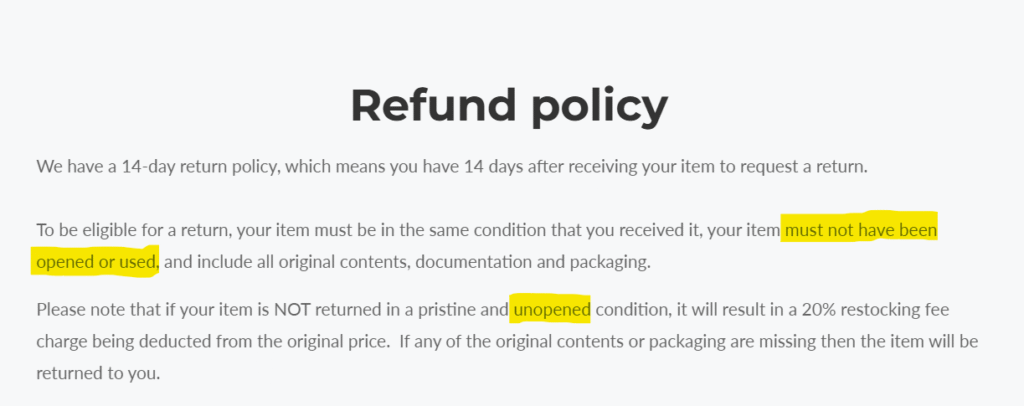Refund Policies: The Bad, The Ugly And What?
I was browsing online for a rather expensive technology device yesterday when I stumbled across this gem of a return policy. Take a look at the highlighted sections and tell me if you can spot the problem:

Let me get this straight. Am I supposed to buy a premium technology device without seeing it, touching it, testing if it works or checking if it fits my needs? Am I supposed to make a permanent purchasing decision based entirely on marketing photos and product descriptions?
This isn’t a viable return policy. It’s customer experience suicide.
The Absurdity in Practice
As I wrote in a previous post about this exact problem: ‘Can anyone tell me the point of a closed-box-only return policy? Because I can’t figure it out.’ The fundamental question remains: are we buying the product or the box?
Imagine this scenario: I order an expensive phone, a high-performance computer or even a basic wireless mouse. It arrives. I’m not allowed to open the box to check the size, test it, feel it or verify that it works with my setup. What exactly am I supposed to decide based on? The attractiveness of the packaging?
This policy essentially forces customers to make irreversible purchasing decisions without any prior experience of the product. It’s the antithesis of customer-centric thinking.
Why Amazon Keeps Winning
Here’s an uncomfortable truth that many retailers are reluctant to acknowledge: Amazon isn’t dominating because of its logistics prowess or competitive prices. They’re winning because of their seamless customer experience at every touchpoint.
As Jan Carlzon identified in his seminal work, Moments of Truth*, every customer interaction is an opportunity to build or destroy trust. Amazon understands this. Most retailers don’t.
When customers know they can easily return something, they can shop with confidence. However, when they encounter restrictive policies such as ‘unopened boxes only’, they either refrain from purchasing altogether or buy elsewhere.
The Legal Loophole Exploitation
European consumer protection laws stipulate that online purchases must be eligible for return within 14 days. Brilliant protection for consumers, right? Not so fast.
While the law requires retailers to offer returns, it doesn’t prevent them from making those returns practically impossible. ‘You can return it, but only if you’ve never touched it, tested it or used it for its intended purpose.’
This isn’t compliance with the spirit of consumer protection. It’s a malicious attempt to discourage returns while technically meeting legal requirements.
The False Economy of Restrictive Policies
I understand the vendor’s concern that opened products are harder to resell. However, here’s what these policies actually cost:
Lost sales: How many potential customers abandon their shopping baskets when they see restrictive returns policies?
Damaged reputation: Every frustrated customer becomes a walking advertisement for your competitors.
Reduced conversion rates: Customers hesitate to purchase when they can’t trust your return policy.
Amazon migration: Customers actively seek out companies with more customer-friendly policies.
Ironically, these restrictive policies often cost more in lost business than they save in processing returns.
The Creativity Deficit
Instead of finding creative solutions to minimise return-related losses, these companies make returns the customer’s problem, and transform the refund policy into a profitable product in itself.
Here’s how customer-centric companies approach the issue:
Display models: If you have physical stores, allow customers to touch and test products before purchase.
Provide clear specifications: Provide detailed measurements, compatibility information and realistic photos.
Partial restocking fees: Instead of refusing returns of opened items entirely, charge reasonable restocking fees for specific categories.
Exchange programmes: Offer easy exchanges for different sizes, colours or specifications.
Video demonstrations: Show the product in use to give customers a clear idea of what they are buying.
However, this approach requires effort, creativity and a genuine focus on the customer. It’s easier to print ‘no returns on opened items’ and call it a policy.
The Trust Equation
Every restrictive return policy sends a clear message to customers. ‘We don’t trust you, and you shouldn’t trust us.’
When customers see policies designed to force them into making purchases, they respond rationally — they shop elsewhere. Businesses with generous return policies aren’t losing money; they’re investing in customer confidence and long-term relationships.
Amazon’s liberal return policy isn’t charity. It’s a strategy. Customers spend more freely when they know they can easily return items. The increased sales volume more than compensates for the costs of processing returns.
The Path Forward
The solution isn’t complicated.
Offer genuine return policies. Allow customers to test products and return them if they are not satisfied.
Invest in the Customer Experience. Make returns easy and not adversarial.
Think long-term. A generous returns policy builds customer loyalty and lifetime value.
Don’t hide behind legal minimums. Just because you can make returns difficult doesn’t mean you should.
Learn from Amazon. Ask yourself why customers prefer businesses with customer-friendly policies.
The Bottom Line
Every ‘unopened box only’ policy gives Amazon and other customer-centric retailers a competitive advantage. While you’re busy making returns difficult, they’re making them effortless.
The choice is simple: either evolve your customer experience, or watch your market share evaporate.
Customer trust isn’t built through restrictive policies designed to trap purchases. It’s built by demonstrating that you stand behind your products and value customer satisfaction over the protection of short-term profits.
If you can’t offer a reasonable returns policy, you can’t complain when Amazon increases its share of the market while yours shrinks.
The question isn’t whether you can legally restrict returns. The question is whether you want customers who trust you enough to buy from you again.
References
*Carlzon, J. (1987). Moments of Truth. Cambridge, MA: Ballinger Publishing.

